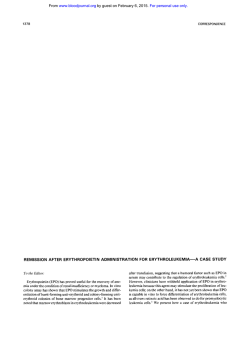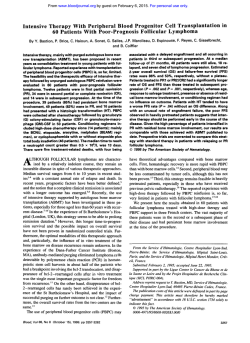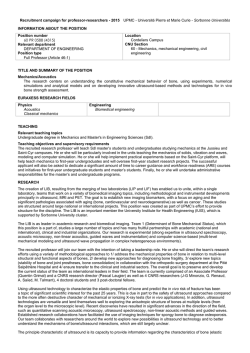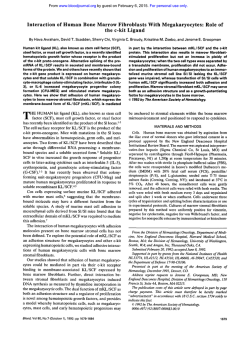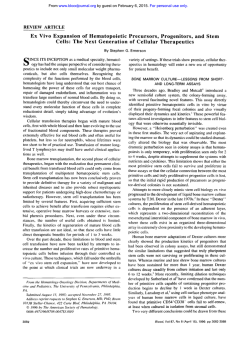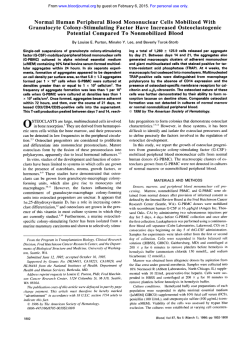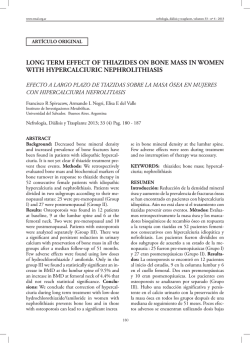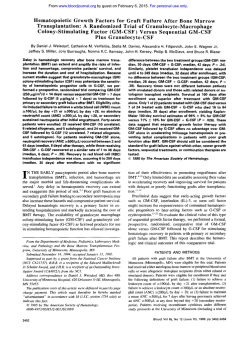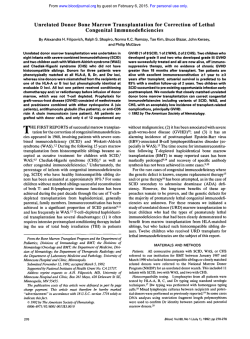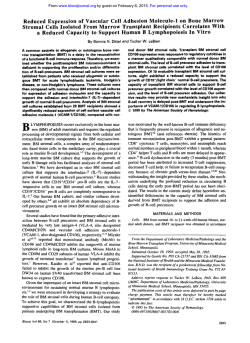
Characterization and Purification of Osteogenic Cells From
From www.bloodjournal.org by guest on February 6, 2015. For personal use only.
Characterization and Purification of Osteogenic Cells From Murine Bone
Marrow by Two-Color Cell Sorting Using Anti-Sca-l Monoclonal Antibody
and Wheat Germ Agglutinin
By P. Van Vlasselaer, N. Falla, H. Snoeck, and E. Mathieu
Osteogenic cells were sorted from bone marrow of 5-fluorouracil (5-FU)-treated mice based on light scatter characteristics, Sca-l expression, and their bindingt o wheat germ
agglutinin (WGA). Four sort gates were established using
forward (FSC) and perpendicular (SSC) light scatter and
were denominated as FSCh"Jh SSC'"", FSC'"" SSChigh, FSC'""
SSC'"", and FSCh'gh SSChfgh
cell. Cells from theFSChighSSChigh
gate, but not from the other gates, synthesized alkaline
phosphatase, collagen, and osteocalcin and formeda mineralized matrix in culture. The number of osteoprogenitorcells
was significantly enriched afterdepleting the 5-FU bone
marrow fromcells of the lymphoid and myeloid
lineage, eg,
Tcells, B cells, natural killer cells, granulocytes, macrophages, and erythrocytes. Approximately 95% of the FSChigh
SSChighcell populationof this "lineage-negative" (Lin-) mar-
row expressed the Sca-l antigen (Sca-l+) and boundWGA.
Three additional sort windows were established based on
WGA binding intensity and were denominated as Sca-l+
WGAduii, Sca-l+ WGAmdium, and Sca-l+WGAbngM.Cells from
gates, synthe Sca-l+WGA"'OM gate, but not from the other
thesized bone proteins and formed a mineralized matrix.
However, they lost this capacity upon subcultivation. Further
immunophenotypic
characterization showed
that
FSChigh SSChighLin- Sca-l+ WGAwht cells expressed stromal
(KM16) and endothelial (Sab-l and Sab-2) markers, but not
hematopoietic surface markers such as c-kif and Thyl.2.
Sorted FSChigh SSChighLin- Sca-l+ WGAbngMcells form threedimensional nodules that stain with the von Kossa technique and containosteoblast and osteocyte-like cells.
0 1994 b y The American Society of Hematology.
B
blood cells were removed by density centrifugation on a 70% Percoll
(Pharmacia, Uppsala, Sweden) gradient.
Cell culture. Bone marrow cells were cultivated inflat-bottom
96-well plates at 5 X lo4 cells per well in Iscove's medium supplemented with10% fetal calf serum (FCS), L-glutamine, penicillin,
streptomycin, ascorbic acid (100 pg/ml), and P-glycerophosphate
(0.6% wt/wt). The cloned osteoprogenitor cell lines MN7"and
MC3T3 E l l5 were cultured in the same medium. For the experiments
in which the self-renewal of sorted cells was studied, the bone marrow cells were cultured until subconfluence, eg, approximately 15
days. These cultures were then passed every 4 days. The cells were
detached from the culture vessel using trypsin.
Measurement ofALP activity. ALP activity was determined on
day 15 of the culture as described elsewhere.I6 The cultures were
incubated with 0.1 mol/L sodium acetate solution supplemented with
0.1% Triton X-100 and 5 mmoVL p-nitrophenol phosphate (Sigma
104; Sigma, St Louis, MO), pH 9.6, for 1 hour at 37°C. Absorbance
was determined at 405 nm and compared with a p-nitrophenol standard titration curve. ALP activity was expressed as nanomoles of pnitrophenol formed per minute.
Collagen synthesis. Collagen synthesis was measured on day
18 of the culture by the incorporation of ['HI-proline (Amersham,
Amersham, UK) into collagenase digestible protein (CDP)." Cell
cultures were incubated with [3H]-proline(1 pCi/well) for 18 hours
at 37°C and then washed three times with phosphate-buffered saline
(PBS). Collagenase (0.1 mg/mL) was added for 1 hour andthe
CDP was measured in a liquid scintillation counter. Collagenase was
ONE MARROW STROMA forms a network of fibroblasts, adipocytes, endothelial cells, and macrophages
that supports and regulates hematopoiesis'.' and harbors cells
of the osteogenic lineage.3.4The latter is illustrated by the
fact that marrow cells differentiate into bone when transplanted in ectopic site^^.^ or when cultured in the presence
of vitamin C and &glyceroph~sphate.~.~
In addition, a number of immortalized and transfected cell lines, generated
from bone marrow stroma, elicited osteogenic characteristics
in culture or when transplanted in vivo.'o.''
In previous reports, we showed that mouse bone marrow
contains 5-fluorouracil (5-FU)-resistant, low-density, nonadherent cells that bind wheat germ agglutinin (WGA) and
that synthesize bone proteins, including alkaline phosphatase
(ALP), collagen type I, and osteocalcin, and form mineralized nodules in ~ u l t u r e . ' ~Apart
"~
from these biophysical
characteristics, little information is available about the immunologic phenotype of these cells. This is not surprising
because osteogenic cells represent only 0.006% of flushed
marrow from 5-FU-treated mice." Moreover, no detailed
enrichment procedures for these cells were available until
today. Nevertheless, it is clear that the understanding of the
role of cell-cell interactions, growth factors, and hormones
during osteogenic differentiation largely depends on the
characterization and purification of the distinct maturation
stages of the osteogenic lineage. The goal of this work wasto
purify and to determine the immune phenotype of osteogenic
cells from the murine bone marrow using fluorescence-activated cell sorting (FACS) technology. This report describes
a FSChighSSChigh
Lin- Sca-l+ WGAbngh'KM16+Sab-l+ Sab2+ Thyl.2- c-kit- cell population that synthesizes bone proteins, including ALP, collagen, and osteocalcin, and that
forms a mineralized matrix when cultured in the presence
of @-glycerophosphateand vitamin C.
MATERIALS AND METHODS
Mice and bone marrow cell preparation. Eight- to ten-week-old
BALB/c mice were administered 5-FU (Roche) at 150 m a g body
weight by tail vein injection. Five days later, the marrow was flushed
from the femora and dispersed into a single-cell suspension. Red
Blood, Vol 84, No 3 (August l), 1994: pp 753-763
From the Department of the Environment, Division of Biology,
Vlaamse Instelling voor Technologisch Onderzoek, Mol; andthe
Department of Biochemistry and Laboratory of Experimental Hematology, Universitaire Instelling Antwerpen, Antwerpen, Belgium.
Submitted June 9, 1993; accepted March 22, 1994.
Supported in part by a grant from the Vlaamse Actieprogramma
Biotechnologie (VL4B/034).
Address reprint requests to P. Van Vlasselaer, PhD, Activated
Cell Therapy, 291 N Bemardo Ave, Mountain View, CA 94043.
The publication costs of this article were defrayed in part by page
charge payment. This article must therefore be hereby marked
"advertisement" in accordance with 18 U.S.C. section 1734 solely to
indicate this fact.
0 1994 by The American Society of Hematology.
0006-4971/94/8403-0015$3.00/0
753
From www.bloodjournal.org by guest on February 6, 2015. For personal use only.
754
purchased from Worthington (UK) and was substantially free of
nonspecific protease activity.
Osteocalcincellenzyme-linkedimmunosorbentassay
(ELISA).
The osteocalcin cell ELISA was performed as described elsewhere."
Briefly, cultures were fixed with 4% cold formaldehyde for 30 minutes at 4°C and then washed with TRIS/HCl buffer (0.05 mol& pH
7.6). Endogenous peroxidase activity was blocked with 3% H202
for 5 minutes. The samples were rinsed with TRIS/HCI buffer and
blocked with normal goat serum (1/5 dilution; Tago, Burlingame,
CA) for 1 hour at37°C. Rabbit-antimouse osteocalcin antiserum
(kindly provided byDr R. Bouillon, Katholic University, Leuven,
Belgium) was added (115,000 dilution) for 2 hours at 4°C. The
cultures were washed with TRIS/HCl buffer and incubated with
horseradish peroxidase-conjugated goat-antirabbit Ig serum (1/2,000
dilution; Tago) for 30 minutes at 4°C. After rinsing, the cultures
were incubated at 37°C with substrate solution (1 mg/mL ABTS +
0.1 pL/mL HZ02in 10.5 g citric acW14.2 g NazHPOJ500 mL H20)
and absorbance was read at 450 nm. Osteocalcin was quantitated on
day 24 of culture. Nonspecific binding of the antimouse osteocalcin
antiserum was determined using nonimmune rabbit serum under the
same conditions. The amount of osteocalcin incorporated in the culture was determined in comparison with a standard ELISA of purified mouse osteocalcin (kindly provided by Dr R. Bouillon, Katholic
University, Leuven, Belgium). The sensitivity of this assay was 0.3
ng/mL. No reactivity was observed with FCS.
Calciumdetermination.
Calcium was determined on day 27of
culture, as described elsewhere." The cell cultures were washed
with Ca2+-and Mgz'-free PBS and incubated overnight with 0.6 N
HCI. The extracted calcium was complexed with o-cresol-phthaleincomplexon (Test Combination Calcium; Boehringer Mannheim,
Mannheim, Germany) and the colorimetric reaction was read at 570
nm. The absolute calcium concentration was determined according
to a standard curve for calcium provided by the vendor.
Limiting dilutionanalysis.
Bone marrow cells were plated at
different densities and stained with the von Kossa technique'" after
30 days of cultivation. The percentage of wells showing no von
Kossa-positive nodules was calculated for each cell plating density
and was plotted against the number of bone marrow cells plated per
well. The number of cells required to form one bone nodule, which
reflected the proportion of osteogenic cells in the entire bone marrow
population, was then determined from the point at which the line
crossed the 37% level.1z~2'
That is, Fo = e - x, where Fo is the
fraction of wells without bone nodules and X is the mean number
of osteogenic cells per well. Based on a Poisson distribution" of
progenitor cells, Fo = 37% corresponds to the dilution at which
there is one progenitor cell per well.
FACS. Cells were sorted on a FACStar Plus flow cytometry
system (Becton Dickinson Inc, San Jose, CA) equipped with a 488nm Argon ion air cooled laser and a 70-pm nozzle. Sorting was
performed at 40 mW lazer beam energy, 10 psi sheath pressure, and
2 psi sample differential pressure. A threshold was set on forward
scatter to gate out debris and dead cells. The cells were sorted
in PBS and collected in FCS-coated tubes. Sorting windows were
established for four separate parameters: forward (FSC) light scatter,
perpendicular (SSC) light scatter, fluorescein isothyocyanate (FITC)
fluorescence, and phycoerythrin (PE) fluorescence. For dual-fluorescence labeling, the cells were incubated with anti-Sca-l antibody
(E13 161-7)" and biotinylated WGA (Boehringer Mannheim) for
30 minutes on ice. The cells were washed and incubated with FITCconjugated rabbit antirat Ig serum (Dako, Glostrup, Denmark) and
streptavidin-PE conjugate (Becton Dickinson) for 30 minutes on ice.
Nonspecific staining was determined by incubating the cells with
equivalent concentrations of FITC and biotinylated isotype-matched
antibodies of irrelevant specificity. Less than 1% of the cells stained
with the negative controls were beyond the gates set for determining
VAN VLASSELAER ET AL
positive Sca-l andWGA staining. Cells were maintained atroom
temperature during sorting. Two sorting protocols were established.
In protocol l, the cells were sorted on light-scatter characteristics
according four sort gates denominated as FSChIghSSC'"". FSC'""
SSCh'gh,FSC'""SSC'"",and
FSChlghSSChIghcell. In protocol 2 ,
FSChtgh
SSCh'rhcells were gated and then sorted based on Sca-l and
WGA staining. To this end, three sort gates were created: Scal + WGA""", Sca-l' WGAmed'"m,
and Sca-l' WGAh"Fh'.For some
experiments, bone marrow was depleted from T cells, B cells, and
natural killer (NK) cells, macrophages, granulocytes, and erythrocytes by panning as described el~ewhere.'~
Bacteriologic petridishes
were coated with rabbit antirat Ig serum or rabbit antimouse Ig serum
(Dako). Marrow cells were incubated for 30 minutes on ice with
the following monoclonal antibodies (MoAbs): RA3-6B2.1 (B220,
mature, and progenitor B cells), RB6-8C5 (Gr-l and granulocytes;
kindly provided by Dr R. Coffman, DNAX, Palo Alto, CA),'5 M I /
70.15.1 1.5.HL (anti-Mac-l and macrophages; American Type Culture Collection [ATCC], Rockville, MD)," M3/38. l .2.8.HL.2 (antiMac-2 and macrophages; ATCC),Z7M3B4.6.34 (anti-Mac-3 and
macrophages; ATCC)," GK1.S (anti-L3T4 and helper T cells:
ATCC),28I 16-13.I (anti-Lyt2 and cytotoxic and suppressor T cells;
ATCC)," PK136 (anti-NK cells; ATCC),'" M1/75.16.4.HLK (antiheat stable antigen [HSA] and mouse red blood cells),2hand J 1 I d.2
(antimature and antiprogenitor erythroid cells; ATCC)."
The marrow cells were then incubated on the coated petridishes
for 2 hour at 37°C. Finally, the respective phenotypes were depleted
for more than 98% as determined by single fluorescence labeling in
FACS analysis.
Phenotypic analysis. Bone marrow from untreated and 5-FUtreated mice, sorted stroma cells collected after the second passage
of cultivation, and cloned MN7 cells" and MC3T3 cells' were
stained using the panel of MoAbs described above extended with
Jlj.10 (anti-Thyl.2; ATCC),3' ACK-2 (anti-c-kit; kindly provided
by Dr S. Nishikawa, Institute for Medical Immunology, Kumamoto,
Japan)," Sab-l and Sab-2 (endothelial cells; kindly provided by Dr
B.A. Imhof, Basel Institute for Immunology, Basel, Switzerland),"
and KM16 (stromal cells; kindly provided by Dr D.G. Osmond,
McGill University, Montreal, Canada).14Statistical analysis was performed using the Lysys I1 program (Becton Dickinson).
Histologicprocedures.
Cultures were fixedin neutral buffered
formalin and selected areas of the cell layer were removed, decalcified with EDTA, embedded in glycol methacrylate, and cut in 3-pm
sections. The sections were stained with hematoxylin and eosin. For
scanning electron microscopy, the cultures were rinsed with PBS
and fixed for 1 hour with sodium-cacodylate buffer in 0.1 m o m
phosphate buffer (pH 7.2). After rinsing, the cultures were postfixed
for 1 hour with 1% osmium tetroxide in the same buffer. The cultures
were subsequently rinsed and progressively dehydrated with alcohol.
They were processed for critical point drying (Balzers Union, Liechtenstein) in COz and coated with gold (50 nm; Balzers Union). The
cultures were observed in a JEOL JSM-FIS microscope.
RESULTS
Osteogenic cells exhibit FSChiEh
and
characteristics. An initial set of experiments was performed to determine the light-scatter characteristics of the osteogenic cell
population from the bone marrow of 5-FU-treated mice. To
this end, the marrow was sorted, ungated, or, according to
four sort gates, denominated asFSC'""
SSChigh,FSChlph
SSChigh,FSC'"" SSC'"", and FSChighSSC'"" (Fig 1). The respective gates represent approximately 4%, 5%, 61%, and
23% of the 5-FU marrow. Because in vivo 5-FU treatment
resultedin a 98% depletion of mononuclear cells of the
From www.bloodjournal.org by guest on February 6, 2015. For personal use only.
755
IMMUNOPHENOTYPE OF OSTEOPROGENITORCELLS
U).
Fig 1. FACScontour plot showing FSCandSSC
characteriatica of bone marrow from 5-FU-treated
mi-. M e r e n t gatesusedforsortingareidentifiad
as FscN.kSSchw, FSC'YSC"'ah, FSPSSCkv, and
FSC"'@SSC"'* cells.
2
.
h
l
58
;C-H\FSC-Height
marrow (data not shown), these gates represent, respectively,
0.08%, 0.1%, 1.2%,and 0.46% of the marrow cells in untreated animals. From the gated sorted cell populations, only
those displaying FSChiBh
SSChiBh
light-scatter characteristics
synthesized bone proteins and mineralized (Table 1). The
other cells, sorted according to FSCIOWSSChgh, FSC'O"
SSCLoW,and FSChighSSC'OW light-scatter characteristics,
showed no osteogenic activity, not even when their cell number per well was increased fourfold (data not shown). It is
clear from the results that, even though equal numbers of
cells were plated, the sorted cells show less osteogenic activity than do the unsorted cells. Consequently, the effect of
the sorting procedure on the osteogenic potential of marrow
cells was verified. Whereas unsorted marrow, plated at 5 X
lo4 cells per well, synthesized detectable amounts of ALP,
collagen, and osteocalcin and formed a mineralized matrix,
-">
equal numbers of ungated sorted marrow cells did not. Microscopic observation of l-day-old cultures showed that, in
contrast to the unsorted cells, a significant number of the
sorted cells failed to adhere. In addition, trypan blue staining
showed that, whereas immediately after sorting 95% of the
cells were viable, only 30% of them remained alive after 24
hours of culture (data not shown). Only when the number
ofungated sorted cells was increased fourfold (2 X lo5
cells per well) was significant bone protein synthesis and
mineralization observed (Table 1).
Enrichment of osteogenic cells by positive depletion of
lymphoid and myeloid cells. It is clear from the data above
that osteoprogenitor cells represent only a minor population
of the 5-Fu bone marrow. The goal was to enrich the osteoprogenitor cell population by panning, using the immunophenotypic characteristics of the 5-W-resistant cells. To
Table 1. Osteogenic Activity of Cells Sorted From Bone Marrow Based on Their Light-Scatter Characteristics
Population*
Unsorted
Ungated
Ungatedt
FSC"SSC'""
FSC'OWSSCh'Oh
FSChbhSSC'"
FSChbhSSChW
ALP p-Nitrophenol (nmol/minl
['HI-Proline (cpm)
Osteocalcin (nghell)
5.2 5 1.1
6,200 ? 826
141.2? 0.2
2
ND
ND
863 ? 115
ND
ND
ND
2.1 t 150
ND
ND
1.1 2 0.2
ND
ND
ND
1,750
2.3 2 0.4
0.70.8
? 0.1
ND
ND
ND
t 0.01
Calcium Ipg/welll
?
0.6
0.3
ND
ND
ND
1.7 5 0.1
Datarepresentthe mean 2 SD of triplicatecultures from onerepresentative experiment. ALP,collagen,osteocalcin,andcalcium
were
24, 27 of culture, respectively. Three experiments were performed. All cells were plated at 5 x lo' cells per
determined on days 15, 18, and
well unless stated otherwise.
Abbreviation: ND, not detectable.
Gates are defined in Fig l.
t A concentration of 2 X 10' cells/well was plated.
From www.bloodjournal.org by guest on February 6, 2015. For personal use only.
756
VAN VLASSELAER ET
3
100
2
80
2
Q,
AL
t
0
a
Q,
f
60
.-c
-&
40
m
t
20
represent
Q,
LL
0
Mael Mae2 Mac3 8220 L3T4
L@
Gr-1 W136 HSA J1 ld.2
this end, FACS analysis was performed on the bone marrow
of untreated and 5-FU-treated mice using lymphoid- and
myeloid-specific MoAbs. Figure 2 shows that, whereas a
large proportion of the myeloid andlymphoid cells are sensitive to the 5-FU treatment, a substantial percentage of them
appear not to be affected by this drug. Consequently, attempts were made to enrich the osteogenic cell population
by depleting the marrow from 5-FU-resistant T cells (L3T4,
Lyt2), B cells (B220), NK cells (PK136), granulocytes (Grl), macrophages (Mac-l, Mac-2, and Mac-3), and erythroid
cells (HSA and Jlld.2) by panning. Panning completely
removed the myeloid and lymphoid cells, as verified by
FACS analysis, and depleted the 5-FU marrow cell number
for 98%, representing 0.004% of the untreated marrow. The
frequency of osteogenic cells in the remaining cell population was verified. In analogy with Bellows and Aubin*' and
Falla et a]," the ability of osteogenic cells to form nodules
that stain positive with the von Kossa technique was used
to determine the frequency of osteogenic cells. Cells from
5-FU marrow and5-FU marrow that was depleted from cells
of the lymphoid and myeloid lineage (Lin-) were plated at
different cell densities in a limiting dilution fashion. Based
on Poisson distribution, the intersect of the corrected line
with the 0.37% level showed that 1 of1.5
X lo4 cells
(0.0067%) in the 5-FU marrow and 1 of 1.1 X lo3 cells
(0.09%) in the 5-FU Lin- marrow had the capacity to form
a mineralized nodule. Taken together, this implies that the
depletion of the 5-FU marrow from lymphoid and myeloid
cells resulted in a 13-fold enrichment of the osteogenic activity (Fig 3).
Osteogenic cells are Scn-l+ WGAbrtXhh'.
The low frequency of osteoprogenitor cells in 5-FU bone marrow urged
us to use other cell sources to define the immunophenotype
of osteoprogenitor cells. In an initial set of experiments, we
determined the immunophenotype of the osteoprogenitor cell
lines MN7 and MC3T3 El. Two-color FACS analysis
showed that more than 98% of the MN7 and MC3T3 E l
osteoprogenitor cells bound WGA and expressed the Sca-l
antigen (Fig 4). In contrast, these cells did not express myeloid (Mac-l, Mac-2, Mac-3, Gr-l, PK136, HSA, or Jlld.2)
or lymphoid (B220, L3T4, or Lyt2) cell surface markers
(data not shown). Based on this information, 5-FU Linmarrow was defined with regard to its double staining with
Fig 2. Effect of 5-FU treatment on the cornposition of murine bone marrow. FACS analysiswas performed on (0)
normal and (m) 5-FU marrow using
MoAbs directed against lymphoid (L3T4, Lyt2, and
8220)
Mac-l,and myeloid (Gr-l,
Mac-2, Mac-3,
antigens.
PK136, HSA,
surface
and Jlld.2) cell
The
bars
the maan percentages 2 SD of three
separate experiments. The values of the 5-FU bone
marrowsignificantly
were in all instances
different
from thosefromthe normal bone marrow ( P < .001).
anti-Sca- l-FITC and WGA-PE. Whereas ungated marrow
contains both single- and double-positive cells, more than
95% of the FSChighSSChighgated cells stained withboth
anti-Sca-l-FITC and WGA-PE (Fig 5). Consequently, the
marrow was firstgated on FSChighSSChigh
characteristics and
then sorted according to three sort gates based on their double staining with anti-Sca-1-FITC and WGA-PE. More precisely, these sort gates were established based on the binding
intensity of the 5-FU marrow cells to WGA and weredenominated as Sca-l+ WGAdU",Sca-l+ WGAmedi"", and Sca-l
WGAhrLgh'
(Fig 5). These gates represent lo%, 13%, and 34%
of the ungated and 6%, 27%, and 62% of the FSChighSSChigh
gated 5-FUmarrow, respectively. The sorted cell populations
were cultivated and ALP, collagen, and osteocalcin synthesis
and mineralization were scored on days 15, 18, 24, and 27
of culture, respectively. Table 2 shows that, in contrast to
+
Number of cells plated per well
l0
o
j
f=1/1100
\
f=1/15000
Fig 3. Limitingdilution analysis ofbone-formingcells in bone marrow from 5-FU-treated mice (01before and (0)after depletion of
lymphoid and myeloid cells. ( 0 1 Undepleted and (01depleted cells
were plated in 60,60,
120, 180. 240. 300, 360, and 420 wells at 5
X lo', 4 x lo', 2 x lo', lo', 8 x l@,
6 x lo', 4 x l@,
2 x lo', and 10'
celb per well (0)
and 4 x l@,
2 x lo3, lo', 8 x lo*, 6 x 102, 4 x
102, 2 x 102, and lo2 cells per well (01, respectively. Cultures were
maintained for 25 days and then stained with the von Kossa technique. The percentage of walls without mineralized nodules 297%
confidence limits was plotted against the number of cells plated per
well.
90.
From www.bloodjournal.org by guest on February 6, 2015. For personal use only.
757
IMMUNOPHENOTYPE OF OSTEOPROGENITORCELLS
MN7
Fig 4. Dual-immunofluorescence analysisof the expression
of
Sca-l
the
antigen and the
binding of WGA on the osteoprogenitorcelllines
MN7 and
MC3T3 E l .
8
to
I
(0
161
l&
l Q1
1 9
Sca-l -FITC
for the expression of (1) the stromal surface antigen KM16,
the unsorted cells, the ungated sorted cells were unable to
(2) the endothelial surface antigens Sab-l and Sab-2, and
produce detectable amounts of bone proteins or to mineralize
(3) the hematopoietic surface antigens Thy 1.2 and c-kit. Durwhen plated at 5 X lo4 cells per well. As mentioned above,
ing the l-week culture period, the sorted cells shed the fluomicroscopic observation showed that this correlated again
resceinated Sca-l antibody and WGA and showed no backwith reduced adherence and decreasing viability of the sorted
ground fluorescence that interfered with the staining for the
cells during subsequent culture. From the gated cell populaKM16, Sab-l, and Sab-2 antigens. Furthermore, during this
tions, only the Sca-l+ WGAbngh'cells synthesized appreciaculture period, the cells increased in number without losing
ble amounts of ALP, collagen, and osteocalcin and mineraltheir osteogenic potential (see below). The FACS analysis
ized in time. It is of interest to note that the sorted cells
shown in Fig 6 illustrates that, in addition to the characterisshowed less osteogenic activity compared with the unsorted
tics described above, 88%, 95%, and 55% of the sorted
cells, even though they were plated at the same density.
osteogenic cells expressed the Kh416, Sab-l, and Sab-2 surHence, the osteogenic activity in the Sca-l+ WGAbngh'gated
face antigens, respectively. In contrast, these cells did not
cell population wasnot enriched in comparison with the
express the Thyl.2 or c-kit surface antigens (Fig 6).
ungated and the unsorted cells.
Self-renewal of F S P g hS S P g hLin- Sca-l+ WGAbngh'
cells
Sorted osteogenic cells express stromal and endothelial
in culture. Osteoprogenitor cells from the rat bone marrow
but not hematopoietic cell su$ace antigens. Thus far, the
were reported to loose their osteogenic activity on progressorting results suggest that osteogenic cells belong to a marsive sub~ulturing.~~
Based on this observation, we deterrow cell population with FSCh@
' ' SSChigh
Lin- Sca-l+ WGAmined the self-renewal potential of osteoprogenitor cells
characteristics. To further define the immunophenotype
of osteogenic cells, FSChighSSCEgbLin- Sca-l+ WGAbngh' sorted from 5-FU marrow. To this end, FSChiEh
SSChigh
LinSca-l' WGAbngh'cells were sorted andcultured until subconcells were sorted and cultured for 1 week and then screened
FSChigh SSChigh GATED
W
20
3
Sca-l -FITC
Fig
Dual-immunofluores5.
cence analysis of the expression
of the Sca-l antigenand
the
bindingofWGAonbonemarrow cellsfrom 5-FU-treated animals before and after gating for
FSChh SSCh'@
characteristics.
Different gatesforsortingare
identified as Sca-l' WGA*",
Sca-l+ WGAmdum, and Sca-l+
WGAbmm.
From www.bloodjournal.org by guest on February 6, 2015. For personal use only.
758
VAN VLASSELAER
ET
AL
Table 2. Osteogenic Activity of Cells Gated on FSCh'ghSSChhh Characteristics
and Then Sorted Based on Their Dual-Fluorescence
Staining With Sca-1-FITC and WGA-PE
Population*
Unsorted
Ungated
Sca-l 'WGAdU"
Sca-l+WGAmed'""
Sca-1
3.1+WGAb"gh'
ALP p-Nitrophenol (nmollmin)
ND
3,273 4.2 2 1.5
ND
ND
ND
2 0.8
('HI-Proline (cprnl
2 421
ND
ND
ND
2,512 2 221
Osteocalcin (ng/well)
Calcium (pgiwell)
6.8 ? 1.1
ND
ND
3.3 2 0.7
ND
ND
ND
3.3 2 0.06
2.1
2
0.4
Data represent the mean 2 SD of triplicate cultures from one representative experiment.
ALP, collagen, osteocalcin, and calcium were
determined o n days 15,18,24, and 27 of the culture, respectively. Three experiments were performed. Unsorted, ungated sorted cells and
sorted cells were plated at 5 x 10' cells per well.
Abbreviation: ND, not detectable.
* Gates are defined in Fig 5.
fluence, eg, approximately day 15 of culture. From that point
on, the cells were subcultured every 4 days. The potential
of the sorted cells to synthesize bone proteins and to mineralize was screened after the third and the fifth passage. More
precisely, cells of the respective passages were cultured and
ALP, collagen, and osteocalcin synthesis and mineralization
was scored at 3 days interval over a period of 15 days. We
like to emphasize that, at the time these cultures were started,
the cells harvested at passages 3 and 5 had been in culture
for 27 and 35 days, respectively. Figure 7 shows that sorted
cells sustained osteogenic activity at least up to three subcultures. At the fifth passage, the cells had lost their ability to
synthesize osteocalcin and to mineralize, although they were
still capable of synthesizing significant amounts of ALP and
collagen. Hence, the osteogenic potential of sorted cells appears to be transient. It is important to note that, in contrast
to the work of McCulloch et al,35 our cultures were performed in the absence of exogenous glucocorticoids.
Morphologic characteristics of F S P g hS S P g h Lin- ScaI + WGAbrighr sorted cells in culture. Microscopic observation showed that sorted FSChighSSChighLin- Sca-l'
WGAbngh'cells have a polygonal fibroblastic appearance (Fig
8A). These cells form distinct three-dimensional nodules that
stain positive with the von Kossa technique (Fig 8B and
C). Histologic examination of hematoxylin and eosin-stained
cross-sections show that these nodules are covered by elongate to cuboidal osteoblast-like cells and contain osteocytelike cells that are embedded in a connective tissue matrix
(Fig 8D and E). A better idea of the matrix component in
these cultures is given by the scanning electron microscopy
micrograph in Fig 8F. This picture shows cellular protrusions
that are embedded in a dense collagenous matrix. Moreover,
mineral deposits can be observed in conjunction with the
collagen fibers.
DISCUSSION
This report describes the phenotypic characterization and
purification of a cell population of the bone marrow of 5FU-treated mice that synthesizes bone proteins including
ALP, collagen, and osteocalcin and that mineralizes when
cultured in the presence of &glycerophosphate and vitamin
C. In an initial set of FACS sorting experiments, osteogenic
Fig 6. FACS histograms
showing the e x p d o n of
KM16, Sab-l, S&-2, Thyl.2, and
c-kit surface antigens on sorted
F&"ph
SSCNah
LinSca-l+
WGAbdgM cells.
From www.bloodjournal.org by guest on February 6, 2015. For personal use only.
759
IMMUNOPHENOTYPE OF OSTEOPROGENITOR CELLS
cells displayed FSChighSSChiphcharacteristics. This complies
with the observation that fibroblast colony-forming unit
(CFU-Fs) of the human marrow showed FSChi* SSC”* chaiacteristics in the FACS
Characteristically, cells displaying a high light scatter have a large size, a low density,
and a complex cytoplasm. This is in agreement with the
biophysical and morphologic characteristics of osteogenic
cells as described by Budenz and Bernard7 and Falla et al.”
From the data in this report it is obvious that sorted cells
show less osteogenic activity than unsorted cells. This is
either caused by a direct effect on the osteogenic potency
of the individual osteoprogenitor cells themselves or by a
sort-induced cell loss. Although the first possibility cannot
be ruled out at this point, it is at least clear from our results
that a significant number of the sorted cells fail to adhere to
the culture flasks and die within a culture period of 24 hours.
It is conceivable that the sorting procedure inhibits the synthesis of extracellular matrix proteins and adhesion molecules that are essential for the survival of osteoprogenitor
cells in culture. In other words, we believe that the sorting
procedure affects the number and the biochemistry of osteoprogenitor cells rather than their potential to synthesize bone
proteins and to form a mineralized matrix. Not only opsteoprogenitor cells suffer during sorting. Indeed, significantly
less numbers of CFU-F were observed in sorted as compared
with unsorted bone marrow (data not shown). Most likely,
this “sorting-effect” is caused by the shearing forces induced by the sorting procedure. In support of this, we experienced that acceptable cell yields were obtained only when
sorting was performed under conditions in which the shearing forces were reduced, eg, low sheath fluid and sample
pressure and clean tubing. In addition, in our hands, overall
cell viability was greatly improved when reduced laser beam
energy was applied and when the cells were sorted in PBS
and collected in undiluted FCS. Taken together, these findings underline once more the fragile nature of osteogenic
cells as mentioned initially by Turksen and A ~ b i nFurther.~~
ALP
p-nitrophenol
(nmovmin)
aooo -
Fig 7. Effect of subcultivation
on the osteogenicpotency of
FSC“’
S S P h Lin- Sca-l+
WGA””
sorted cells. FSCbh
SSCkieh Lin- Sca-l’ WGA”
cells were sorted and cultured.
At subconfluence (day 151, the
cells were paased every 4 days.
Cells of passage numbers 3 (0)
and 5 1.1 were taken and cultivated in 96well multiwell
plates. ALP activity and collagen
and osteocaldn synthesis and
mineralization was determined
at 3-day intervals for a period of
15 days.
more, this may explain the troubles people encounter in trying to purify these cells by flow cytometry means.
To sort osteogenic cells by FACS on the basis of their
immunologic phenotype, anumber of presort enrichment
procedures were performed. In addition to in vivo treatment
with 5-FU, which resulted in a 95% reduction of the mononuclear cells of the marrow, we initially tried to deplete the
marrow cell number using magnetic bead separation and
complement lysis (data not shown). These techniques proved
not to be satisfactory because osteogenic cells bind nonspecifically to the beads and because onlyminor depletions
were obtained using complement. Alternatively, marrow cell
depletion was tried by panning. Using MoAbs directed to
lymphoid and myeloid cell surface antigens, this technique
reduced 5-FU marrow for 98%. Because the ‘‘lineage’’-depleted marrow showed increased osteogenic activity in limiting dilution, panning can be considered as a useful procedure for the enrichment of osteogenic cells. Furtheimore,
this observation suggests that osteogenic cells from the
mouse bone marrow do not express lymphoid or myeloid
cell surface markers. This is in agreement with the data of
Piersma et a13’ showing that murine CFU-F do not express
B220, Mac-l, and Thy1 surface antigens. We like to emphasize that our data refer to osteoprogenitor cells of the bone
marrow and that by no means can it be excluded that cells
with a more mature osteoblastic phenotype may express a
different immunologic phenotype, including the expression
of cell surface markers, especially those of the lymphoid or
myeloid lineage.
The low frequency of osteoprogenitor cells in the bone
marrow made it technically difficult to determine the immunophenotypical parameters by which these cells could be
sorted by FACS. Therefore, we first definedthe immunologic
phenotype of established osteoprogenitor cell lines and used
that information to make an educaied guess on which parcheters would be useful to sort the osteoprogenitor cells from
the marrow. In a number of preliminary experiments, FACS
Collagen
BHI-Proline
(wm)
3000 2000 1000 4
From www.bloodjournal.org by guest on February 6, 2015. For personal use only.
760
Fig 8. Morphologic characteristics of sorted FSChighSSChigh
Lin- Sca-l' WGAbdghtcells in culture. (A and B) Phase-contrast micrographs of
%-day-old (original magnification x 3601 and 27-day-old (original magnification x 50) cultures, respectively. Note the polygonal cells in (A)
and the three-dimensional nodule
in (B). IC)A 25-day-old culture showinga nodule stainedwith thevon Kossa technique (original magnification
x 2001. (D and E) Hematoxylin andeosin-stained cross-sections through a25-day-old, demineralized nodule. Osteoblast-like cells (arrow) cover
the top of the nodule
and osteocyte-like cells (arrowheads) can be observed in thenodules. (F) Scanning electron microscopy picture of a 26day-old culture. Note the collagenous matrix (white arrow) and the calcium phosphate mineral deposits (black arrow) in between the cell
protrusions (white arrowheads).
analysis showed that osteoprogenitor cells such as MN7 and
MC3T3 El expressed the Sca-I antigen and bound intensely
to WGA. The latter is in agreement with the observation of
Falla et al" that osteogenic cells were removed from the
marrow after WGA agglutination and sedimentation. According to these findings, osteogenic cells were sorted from
Lin- 5-FU marrow on the basis of their Sca- I expression
and WGA binding. As described by Ploemacher and Brons.39
the mousemarrowcanbe
subdivided in four populations
WGA""",
based on its binding intensity to WGA: WGAneC"""',
WGAmCdiUm
, and WGAhrtFh'.
In analogy with these investigators, we sorted 5-FU bone marrow cells according to these
From www.bloodjournal.org by guest on February 6, 2015. For personal use only.
IMMUNOPHENOTYPE OF OSTEOPROGENITOR CELLS
sort gates. We were repeatedly able to sort osteogenic cells
from the Sca-l+ WGAb"gh'population. This implies that the
osteogenic cells of the marrow share at least a number of cell
membrane characteristics with immortalized osteoprogenitor
cell lines.
Recently, Huang and Terstappenm described a CD34+
HLA-DR- CD38- pluripotent stem cell in the human fetal
bone marrow that can differentiate into hematopoietic precursors and stromal cells that are capable of supporting these
precursors. Moreover, in culture, these cells showed ALP
activity and extensive chondroitin sulphate immunoreactivity consistent with osteoblast and chondroblast differentiation. Thus, there is mounting evidence that hematopoietic
and stromal cells originate from the same undifferentiated
precursor. This idea was further supported by the work of
Ardavin et a14' showing that thymic dendritic cells and T
cells develop simultaneously in the thymus from a common
precursor population. Furthermore, the fact that the cell surface antigen CD34 is expressed on cells of both the hematopoietic and stromal lineages36further illustrates this idea. In
this context, Sca-l expression on osteogenic cells may be of
particular interest because Spangrude et al" showed that
Sca- 1 in combination with Thy- 1 expression could be used to
sort hematopoietic stem cells from the marrow. In addition,
hematopoietic stem cells were shown to bind toWGA.39
Thus, Sca-l expression and WGA binding by osteogenic
cells may refer to the existence of a common pluripotent stem
cell for hematopoietic and stromal cells. However, some
observations indicate that sorted FSChighSSChighLin- Scal + WGAbngh'cells from adult 5-W-treated bone marrow
are irreversibly differentiated and committed to the stromal
lineage. First of all, FSChlghSSChighLin- Sca-l+ WGAbngh'
cells showed no hematopoietic activity in culture as determined by CW-granulocyte-macrophage assay (data not
shown). Secondly, they are WGAbngh',whereas cells of the
hematopoietic lineage display a WGAdU"phenotype.39Furthermore, FSChiphSSChigh
Lin- Sca-l+ WGAbngh'cells do not
express the hematopoietic cell surface antigens Thy-l and
c-kit. However, on the other hand, they express the cell
surface antigens KM16, Sab-l, and Sab-2, which are restricted to cells of the stromal lineage.33.34
It was previously shown by McCulloch et a19 that osteoprogenitor cells of the rat bone marrow exhibit self-renewal
in culture. At least they were able to sustain osteogenic
activity during subcultivation for up to four passages. In
addition, Bellows Gt a143showed that nodule formation and
maintenance of rat calvaria cells in culture is significantly
increased in the presence of dexamethasone. Indeed, mass
population studies"." and limiting dilution analysis2' suggest
that a subpopulation of calvaria cells is dependent on dexamethasone or natural glucocorticoids for expression of bone
nodule formation. Similarly, our data showthat the selfrenewal of FSChighSSChighLin- Sca-l+ WGAbnghtcells is
limited and diminishes during subculturing. In addition, the
time course of osteocalcin synthesis and calcium uptake by
the sorted cells in the self-renewal study are different from
the unsorted cells shown previously by Falla et
This
report shows a time course of bone protein synthesis and
mineralization in primary cultures of bone marrow cells from
761
5-W-treated mice. In these cultures, osteocalcin synthesis
and mineralization was insignificant during the first 12 days
of the culture and rapidly increased from then on. In contrast,
the fractionated cells in the self-renewal study did not show
such a latency period and significant levels of osteocalcin
synthesis and mineralization were observed from the onset
of the cultures. In situ hybridization data in the report by
Falla et all2 showed that cells flushed from the bone marrow
do not express detectable levels of osteocalcin. Therefore,
the latency period in osteocalcin synthesis and mineralization
in these cultures reflects most likely the time necessary for
"naive" cells to progress through the different steps of osteoblastic differentiation. To study the self-renewal potency
of fractionated cells, FSChighS S C ~ gLinh Sca-l+ WGAbngh'
cells were cultured until subconfluence before they were
passaged at 4-day intervals. In other words, Fig 7 reflects
the time course of bone protein synthesis and mineralization
of cells that, at the time of plating, had been cultured for 27
(passage 3) and 35 (passage 5) days, respectively. Thus, at
the moment of plating, the cells used for the self-renewal
experiments had already reached a distinct level of osteoblastic differentiation, eg, they already expressed osteocalcin.
Hence, in our opinion, this explains the difference in the time
courses of osteocalcin synthesis and mineralization between
unfractionated and fractionated cells. On the other hand, no
real differences were observed in the time courses of ALP
activity and collagen synthesis. Both proteins are continuously expressed by unfractionated fresh bone marrow cells,
which explains why they are synthesized from the onset of
cultures of both unfractionated and fractionated cells. No
studies were performed with dexamethasone because a previous study indicated that the osteogenic activity of mouse
bone marrow was significantly reduced in the presence of
to 10"' mol dexamethasone." In addition, cultured
FSChighSSChigh
Lin- Sca-l+ WGAbngh'cells readily detached
from the culture dish and died in the presence ofmol
hydrocortisone (data not shown). Whereas it is perfectly possible that the osteogenic activity of these cells depends on
the presence of endogenous glucocorticoids in the medium,
they definitely do not require exogenous supplementation of
glucocorticoids. Further studies using steroid-depleted medium are necessary to determine the requirement of glucocorticoids for osteoblastic differentiation in this model.
In a previous report, we showed that bone marrow from
5-W-treated mice form three-dimensional structures that
stain with the Von Kossa technique and that contain osteoblast and osteocyte-like cells. Scanning electron microscopy
illustrated the presence of a mineralized matrix filling up
the extracellular spaces.I2 Morphologic studies showed that
FSChighSSChigh
Lin- Sca-l+ WGAbngh'sorted cells form nodules that stain with the Von Kossa technique. Furthermore,
these nodules contain osteoblast and osteocyte-like cells that
resemble those formed by unsorted bone marrow and calvaria cells from the mouse12and from other species such as
the rat and h ~ m a n . 4 ~Under
- ~ * no circumstances were we able
to obtain mineralized cultures using cells sorted according
to characteristics different from FSChighSSChighLin- Sca- 1
WGAbngh'(data not shown).
In conclusion, FACS sort technology appears to be useful
+
From www.bloodjournal.org by guest on February 6, 2015. For personal use only.
762
VAN VLASSELAER ET AL
for the characterization of osteoprogenitor cells of the marrow. However, because this technology results in a significant loss of viable cells, more efforts have to be taken to
fine tune this technology. In this context, large nozzle sorting
may be a plausible option.
ACKNOWLEDGMENT
We thank J. Maes for technical support.
REFERENCES
I. Dexter TM: Stromal cells associated with hematopoiesis. J Cell
Physiol Suppl 1:87, 1982
2. Allen TD, Dexter TM: The essential cells of the hematopoietic
environment. Exp Hematol 12517, 1984
3. Friedenstein AJ: Precursor cells of mechanocytes. Int Rev Cyto1 47:327, 1976
4. Owen ME: Lineage of osteogenic cells and their relationship
to the stromal system. Bone Miner Res 3:1, 1980
5. Ashton BA, Allen TD, Howlett CR, Eaglesom CC, Hattori A,
Owen ME: Formation of bone and cartilage by marrow stromal cells
in diffusion chambers in vivo. Clin Orthop 151:294, 1980
6. Friedenstein M : Stromal mechanisms of bone marrow: Cloning in vitro and retransplantation in vivo, in Thienfelder S (ed):
Immunobiology of Bone Marrow Transplantation. Berlin, Germany,
Springer-Verlag, 1980, p 19
7. Budenz RA, Bernard GW: Osteogenesis and leukopoiesis
within diffusion chamber implants of isolated bone mmow subpopulAnat 159:455, 1980
lations. Am .
8. Howlett CR, Cave J, Williamson M, Farmer J, Ali SY, Bab I,
Owen ME: Mineralization inin vitro cultures of rabbit marrow
stromal cells. Clin Orthop 213:251, 1986
9. McCulloch CAG, Struguresco M, Hughes F, Melcher AH, Aubin JE: Osteogenic precursor cells in rat bone marrowstromal populations exhibit self-renewal in culture. Blood 77:1906, 1991
IO. Benayahu D, Kletter Y, Zipori D, Wientroub S : Bone marrowderived stromal cell line expressing osteoblastic phenotype in vitro
and osteogenic capacity in vivo. J Cell Physiol 140:1, 1989
1 I . Mathieu E, Schoeters G, Van der Plaetse F, Merregaert J:
Establishment of an osteogenic cell line derived from adult mouse
bone marrow stroma by useof a recombinant retrovirus. Calcif
Tissue Int 50:362, 1992
12. Falla N, Van Vlasselaer P, Bierkens J, Borremans B, Schoeters G, Van Gorp U: Characterization of a 5-fluorouracil-enriched
osteoprogenitor population of the murine bone marrow. Blood
82:3580, 1993
13.Van Vlasselaer P, Borremans B,VanDen Heuvel R,Van
Gorp U, De Waal R: Interleukin 10 inhibits the osteogenic activity
of mouse bone marrow. Blood 82:2361, 1993
14.Van Vlasselaer P, Borremans B,Van Gorp U, Dasch JR.
De Waal R: Interleukin 10 inhibits TGF-P synthesis required for
osteogenic commitment of mouse bone marrow cells. J Cell Biol
124569, 1994
15. Sudo H, Kodama H, Amagai Y, Yamamoto S , Kasai S: In
vitro differentiation and calcification in a new clonal osteogenic cell
line from newborn mouse calvaria. J Cell Biol 96:191, 1983
16. Lowry OH, Roberts NR, Wu M, Hixen WS, Crawford D:
The quantitative histochemistry of brain. 11. Enzyme measurements.
J Biol Chem 207:13, 1954
17. Peterkovsky B, Diegelmann R: Use of a mixture of proteinase-free collagenase for the specific assay of radioactive collagen in
the presence of other
Biochemistry 20:3523, 1985
18. Van Vlasselaer P: Indirect cellular ELISA for adherent cultures, in Colligan JE, Kruisbeek AM, Margulies DH, Shevach EM,
Strober W (eds): Current Protocols in Immunology. New York. NY,
Greene Publishing and Wiley-Interscience, 1992 (suppl 2)
19. Gitelman HJ: An improved automated procedure for the determination of calcium in biological specimens. Anal Biochem 1852 I ,
1967
20. Von KossaJ:Uber die im organismus kuntzlicht erzeugen
Verkalkungen. Beitr Anat 29: 163, 1901
21. Bellows CG, Aubin JE: Determination of numbers of osteoprogenitors present in isolated fetal rat calvaria cells in vitro. Dev
Biol 133:8, 1989
22. Henry C, Marbrook J, Vann DC, Kodlin D, Wofsy C: Limiting dilution analysis, in Mishell BB, Shiigi WS (eds): Selected
Methods in Cellular Immunology. New York, NY, Freeman, 1980,
p 138
23. Aihara Y , Huhring H, Aihara M, Klein J: An attempt to
produce “pre-T cells” hybridomas andto identify their antigens.
Eur J Immunol 16:1391, 1986
24. Wysocki LJ, Sat0 VL: “Panning” for lymphocytes: A method
for cell selection. Proc Natl Acad Sci USA 75:2844, 1978
25. Coffman RL, Weissman IL: B220: A B cell-specific member
of the T200 glycoprotein family. Nature 289:289, 198 I
26. Springer T, Galfre G, Secher DS, Milstein C: Monoclonal
xenogeneic antibodies to murine cell surface antigens: Identification
of novel leukocyte differentiation antigens. Eur J Immunol 8539,
1978
27. Springer TA: Monoclonal antibody analysis of complex biological systems. J Biol Chem 256:3833, 1981
28. Dialynas DP, Wilde DB, Marrack P, Pierres A, Wall KA,
Havran W, Otten G, Loken MR, Pierres M, Kappler J, Fitch F W :
Characterization of the murine antigenic determinant, designated
L3T4a, recognized by monoclonal antibody GK1.5: Expression of
the L3T4a by functional T cell clones appears to correlate primarily
with class I1 MHC antigen-reactivity. Immunol Rev 74:29, 1983
29. Sarmiento M, Glasebrook AL, Fitch FW: IgG or IgM monoclonal antibodies reactive with different determinants on the molecular complex bearing Lyt 2 antigen block T cell-mediated cytolysis
in the absence of complement. J Immunol 125:2665, 1980
30. Koo GC, Dumont FJ, Tutt M, Hackett J, Kumar V: The NK1.1(- ) mouse: A model to study differentiation of murine NK cells.
J Immunol 137:3742, 1986
31. Bruce J, Symington FW, McKeam TJ, Sprent J: A monoclonal antibody discriminating between subsets of T and B cells. J
lmmunol 127:2496, 1981
32. Ogawa M, Matsuzaki Y, Nishikawa S , Hayashi S, Kunisada
T, Sudo T, Kina T, Nakaushi H, Nishikawa S : Expression and functionof c-kit in hemopoietic progenitor cells. J Exp Med 174:63,
1991
33.Imhof BA, Schlienger C, Handloser K, Hesse B, Slanicka
M, Gisler R: Monoclonal antibodies that block adhesion of B cell
progenitors to bone marrow stroma in vitro prevent B cell differentiation in vivo. Eur J Immunol 21:2043, 1991
34. Jacobsen K, Miyake K, l n c a d e PW, Osmond DG: Highly
restricted expression of a stromal cell determinant in mouse bone
marrow in vivo. J Exp Med 176:927, 1992
35. McCulloch CAG, Strugurescu M, Hughes F, Melcher AH,
Aubin JE: Osteogenic progenitor cells in rat bone marrow stromal
populations exhibit self-renewal in culture. Blood 77:1906, 1991
36. Simmons PJ, Torok-Storb B: CD34 expression by stromal
precursors innormalhuman adult bone marrow. Blood 78:2848,
1991
37. Turksen K, Aubin JE: Positive and negative immunoselection
for enrichment of two classes of osteoprogenitor cells. J Cell Biol
114:373,1991
38. Piersma AH, Brockbank KGM, Ploemacher RE, vanVliet
From www.bloodjournal.org by guest on February 6, 2015. For personal use only.
IMMUNOPHENOTVPE OF OSTEOPROGENITORCELLS
E, Brakel-van Peer K P J , Visser PJ: Characterizationof fibroblastic
stromal cells from murine bone marrow. Exp Hematol
13:237,1985
39. Ploemacher RE, Brons NHC: Isolation of hemopoietic stem
cell subsets from murine bone marrow. II. Evidence for anearly
precursor of day-l2 CFU-S and cells associated with radioprotective
ability. Exp Hematol 1697, 1988
40. Huang S , Terstappen LW": Formation of haematopoietic
microenvironment and hematopoietic stem cells from single human
bone marrow stem cells. Nature 360:745, 1993
41. Ardavin C, Wu L, Li C, Shortman K: Thymic dendritic cells
and T cells develop simultaneously in the thymus from a common
precursor population. Nature 362761, 1993
42. Spangrude GJ, Heimfeld S , Weissman IL: Purificationand
characterizationof mouse hematopoietic stemcells. Science24158,
1988
43. Bellows CG, Heersche JNM, Aubin JE: Determination of the
capacity for proliferation and differentiation
of osteoprogenitor cells
763
in the presence and absence of dexamethasone. Dev Biol 140132,
1990
44. Bellows CG, AubinJE, Heersche JNM, Antosz ME: Mineralized bone nodules formed in vitro from enzymatically released rat
calvaria cell populations. Calcif Tissue Int 38:143, 1986
45.HaynesworthSE,Goshima
J, GoldbergVM,CaplanAI:
Characterizationof cells with osteogenic potential from
human bone
marrow. Bone 13:81, 1992
46. Nefussi JR, Boy-Lefevre ML, Boulekbache H, ForestN: Mineralization in vitro of matrix formed byosteoblasts isolatedby collagenase digestion. Differentiation 29:160, 1985
47. Bellows CG, AubinE. Heersche JNM, Antosz ME:Mineralized bone nodules formed in vitro from enzymatically released rat
calvaria cell populations. Calcif Tissue Int 38: 143, 1986
48. Bhargava U, Bar-Lev M, Bellows CG, Aubin JE: Ultrastructural analysis of bone nodules formed in vitro by isolated fetal rat
calvaria cells. Bone 9:155, 1988
From www.bloodjournal.org by guest on February 6, 2015. For personal use only.
1994 84: 753-763
Characterization and purification of osteogenic cells from murine
bone marrow by two-color cell sorting using anti-Sca-1 monoclonal
antibody and wheat germ agglutinin
P Van Vlasselaer, N Falla, H Snoeck and E Mathieu
Updated information and services can be found at:
http://www.bloodjournal.org/content/84/3/753.full.html
Articles on similar topics can be found in the following Blood collections
Information about reproducing this article in parts or in its entirety may be found online at:
http://www.bloodjournal.org/site/misc/rights.xhtml#repub_requests
Information about ordering reprints may be found online at:
http://www.bloodjournal.org/site/misc/rights.xhtml#reprints
Information about subscriptions and ASH membership may be found online at:
http://www.bloodjournal.org/site/subscriptions/index.xhtml
Blood (print ISSN 0006-4971, online ISSN 1528-0020), is published weekly by the American
Society of Hematology, 2021 L St, NW, Suite 900, Washington DC 20036.
Copyright 2011 by The American Society of Hematology; all rights reserved.
© Copyright 2025
